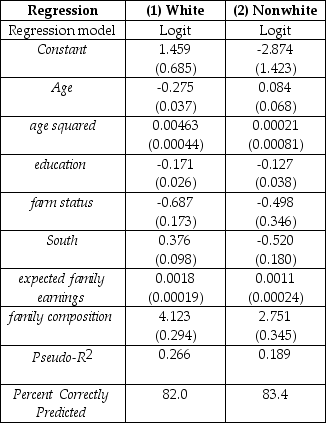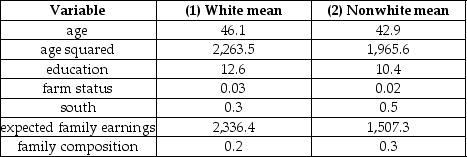A study tried to find the determinants of the increase in the number of households headed by a female.Using 1940 and 1960 historical census data,a logit model was estimated to predict whether a woman is the head of a household (living on her own)or whether she is living within another's household.The limited dependent variable takes on a value of one if the female lives on her own and is zero if she shares housing.The results for 1960 using 6,051 observations on prime-age whites and 1,294 on nonwhites were as shown in the table:
 where age is measured in years,education is years of schooling of the family head,farm status is a binary variable taking the value of one if the family head lived on a farm,south is a binary variable for living in a certain region of the country,expected family earnings was generated from a separate OLS regression to predict earnings from a set of regressors,and family composition refers to the number of family members under the age of 18 divided by the total number in the family.
where age is measured in years,education is years of schooling of the family head,farm status is a binary variable taking the value of one if the family head lived on a farm,south is a binary variable for living in a certain region of the country,expected family earnings was generated from a separate OLS regression to predict earnings from a set of regressors,and family composition refers to the number of family members under the age of 18 divided by the total number in the family.
The mean values for the variables were as shown in the table.
 (a)Interpret the results.Do the coefficients have the expected signs? Why do you think age was entered both in levels and in squares?
(a)Interpret the results.Do the coefficients have the expected signs? Why do you think age was entered both in levels and in squares?
(b)Calculate the difference in the predicted probability between whites and nonwhites at the sample mean values of the explanatory variables.Why do you think the study did not combine the observations and allowed for a nonwhite binary variable to enter?
(c)What would be the effect on the probability of a nonwhite woman living on her own,if education and family composition were changed from their current mean to the mean of whites,while all other variables were left unchanged at the nonwhite mean values?
Correct Answer:
Verified
View Answer
Unlock this answer now
Get Access to more Verified Answers free of charge
Q22: Consider the following logit regression:
Pr(Y = 1
Q23: (Requires Advanced material)Nonlinear least squares estimators in
Q23: A study investigated the impact of house
Q25: A study analyzed the probability of Major
Q26: When estimating probit and logit models,
A)the t-statistic
Q28: To measure the fit of the probit
Q30: Probit coefficients are typically estimated using
A)the OLS
Q30: In the probit regression,the coefficient β1 indicates
A)the
Q31: The logit regression (11.10)on page 393 of
Q36: (Requires Advanced material)Maximum likelihood estimation yields the
Unlock this Answer For Free Now!
View this answer and more for free by performing one of the following actions

Scan the QR code to install the App and get 2 free unlocks

Unlock quizzes for free by uploading documents